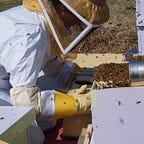DIY Bee Removal Mistakes to Avoid
In a world where every solution can be found online, many people prefer to take the DIY approach to most problem-solving. Bee removal is one of those, and although there is a ton of helpful information available, some can be misleading and dangerous. Not everything you read works and, worse yet, some tips may make the bees aggressive and result in a trip to the ER. To ensure that doesn’t happen to you, here are a couple of DIY free bee removal mistakes to be wary of:
1) Using spray foam to seal bees in
This a common DIY home solution that happens all the time. People spot a few honey bees continually coming in and out of a crack in the wall, and they seal the opening up with caulk or spray foam, and they think that’s the end of that. The problem though is that’s not the end but the beginning of your troubles.
Bees usually live in large numbers, typically into the thousands, and you may have sealed an entire hive of bees under the roof or into your wall. They’ll find a way out sooner or later, maybe through the light fixtures or ventilation, and they’ll not be too happy when they get out. Angry bees may flood into your home!
Alternatively, returning bees locked outside may become agitated, resulting in home stings. Sealing in bees also makes it a difficult job for bee removal experts to uncover the scale of the problem, which means you’ll spend more money and time to fix the issue.
2) OTC sprays and soapy water remedies
Soapy water and OTC sprays work when used properly, but they sometimes don’t solve the problem in its entirety. The problem with pesticides is that every bee in the hive needs to come in contact with the chemical for that to be effective, and you’re talking about 6,000 to 10,000 bees confined within the roof or wall. You can get stung in the process, and not all the bees will be affected.
Also, the honeybee population in the world doesn’t look good at the moment. Pesticides are harmful to these and other beneficial insects we rely on for plant pollination and, by extension, food production. Consequently, remedies that bring harm to bees aren’t the way to go if you care about the world and posterity. Pesticides kill biodiversity and also accelerate pollution and global warming.
3) Smoking out bees
Smoke can confuse bees and make them less aggressive than usual, but that has to be paired with some other bee removal measure. The smoke is like a sedative that makes them docile for a while, but it rarely scares them off the hive for good. Even if they do leave, they tend to return when the smoke dies out, so this may not be a permanent solution.
Lighting fires can also lead to the inadvertent destruction of the hive, causing the deaths of insects that help us in so many ways. Worse yet, unmonitored smoldering fires can result in damage to the surrounding plant life, your yard, and may spread to your home.
4) Waiting it out
Some people think that if they do nothing the bees will buzz off to a new home when they get tired of an old one. Unlike broken hearts, time doesn’t heal all here; if anything, it can make things worse. Honeybees can stay in a single hive for a really long time, and waiting gives the hive time to develop into a complex and fully-populated structure that’ll be hard to deal with when you conclude that waiting isn’t working out.
Whenever you spot an infestation, report it as soon as possible and have someone experienced take a look for you. Stray honey dwindling down the inside of your walls can compromise the structural integrity of your house over time, and other pests, including new bees, may be drawn to your home because of the continued presence of the hive.
Play it safe and call in an expert
Without the requisite knowledge to perform safe bee removal, you’ll be endangering not only the bees’ lives but also your own. Always opt for professional bee removal services so you can stay out of harm’s way and ensure that Mother Nature’s well-being is also factored into the equation.
